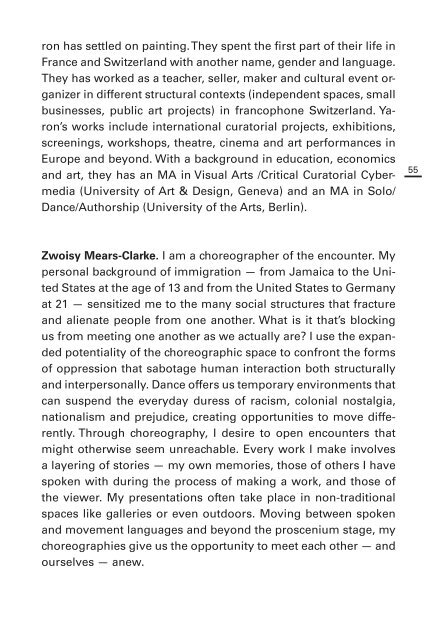Laboratory on Feedback in Artistic Processes 3
In its third edition the "Laboratory on Feedback in Artistic Processes" reflects on "Responses" within performing arts. The results of the previous Labs highlighted the need to take a closer look at the complexity and often subtle implications of feedback within the the artistic process itself. How do artist organise feedback and how do they process it? Who they want feedback from and what are its different roles? How can describe these relationships, and how does it shpae the artistic work? This booklet presents the different views on and experiences of feedback practices that were elaborated during the lab along the beforementioned questions and the insightfull contributions of its participants. Underpinning the following pages, three thematic fields have emerged: the impacts of feedback, feedback as a tool, and practicalities and contexts of feedback.
In its third edition the "Laboratory on Feedback in Artistic Processes" reflects on "Responses" within performing arts. The results of the previous Labs highlighted the need to take a closer look at the complexity and often subtle implications of feedback within the the artistic process itself. How do artist organise feedback and how do they process it? Who they want feedback from and what are its different roles? How can describe these relationships, and how does it shpae the artistic work?
This booklet presents the different views on and experiences of feedback practices that were elaborated during the lab along the beforementioned questions and the insightfull contributions of its participants. Underpinning the following pages, three thematic fields have emerged: the impacts of feedback, feedback as a tool, and practicalities and contexts of feedback.
Create successful ePaper yourself
Turn your PDF publications into a flip-book with our unique Google optimized e-Paper software.
<strong>on</strong> has settled <strong>on</strong> pa<strong>in</strong>t<strong>in</strong>g. They spent the first part of their life <strong>in</strong><br />
France and Switzerland with another name, gender and language.<br />
They has worked as a teacher, seller, maker and cultural event organizer<br />
<strong>in</strong> different structural c<strong>on</strong>texts (<strong>in</strong>dependent spaces, small<br />
bus<strong>in</strong>esses, public art projects) <strong>in</strong> francoph<strong>on</strong>e Switzerland. Yar<strong>on</strong>’s<br />
works <strong>in</strong>clude <strong>in</strong>ternati<strong>on</strong>al curatorial projects, exhibiti<strong>on</strong>s,<br />
screen<strong>in</strong>gs, workshops, theatre, c<strong>in</strong>ema and art performances <strong>in</strong><br />
Europe and bey<strong>on</strong>d. With a background <strong>in</strong> educati<strong>on</strong>, ec<strong>on</strong>omics<br />
and art, they has an MA <strong>in</strong> Visual Arts /Critical Curatorial Cybermedia<br />
(University of Art & Design, Geneva) and an MA <strong>in</strong> Solo/<br />
Dance/Authorship (University of the Arts, Berl<strong>in</strong>).<br />
55<br />
Zwoisy Mears-Clarke. I am a choreographer of the encounter. My<br />
pers<strong>on</strong>al background of immigrati<strong>on</strong> — from Jamaica to the United<br />
States at the age of 13 and from the United States to Germany<br />
at 21 — sensitized me to the many social structures that fracture<br />
and alienate people from <strong>on</strong>e another. What is it that’s block<strong>in</strong>g<br />
us from meet<strong>in</strong>g <strong>on</strong>e another as we actually are? I use the expanded<br />
potentiality of the choreographic space to c<strong>on</strong>fr<strong>on</strong>t the forms<br />
of oppressi<strong>on</strong> that sabotage human <strong>in</strong>teracti<strong>on</strong> both structurally<br />
and <strong>in</strong>terpers<strong>on</strong>ally. Dance offers us temporary envir<strong>on</strong>ments that<br />
can suspend the everyday duress of racism, col<strong>on</strong>ial nostalgia,<br />
nati<strong>on</strong>alism and prejudice, creat<strong>in</strong>g opportunities to move differently.<br />
Through choreography, I desire to open encounters that<br />
might otherwise seem unreachable. Every work I make <strong>in</strong>volves<br />
a layer<strong>in</strong>g of stories — my own memories, those of others I have<br />
spoken with dur<strong>in</strong>g the process of mak<strong>in</strong>g a work, and those of<br />
the viewer. My presentati<strong>on</strong>s often take place <strong>in</strong> n<strong>on</strong>-traditi<strong>on</strong>al<br />
spaces like galleries or even outdoors. Mov<strong>in</strong>g between spoken<br />
and movement languages and bey<strong>on</strong>d the proscenium stage, my<br />
choreographies give us the opportunity to meet each other — and<br />
ourselves — anew.


















